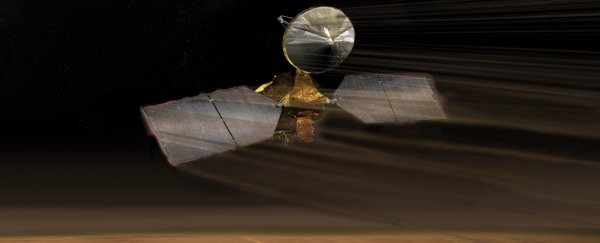We've arrived at a sad realisation. A handful of pixels in about 90 percent of the images taken by one of the major instruments on NASA's Mars Reconnaissance Orbiter are showing things that just aren't there.
Researchers uncovered the error after searching for better signs of moisture-absorbing materials on the Martian surface. Not only did they turn out to be a mirage, doubts have now been raised over the precise distribution of water across the planet.
The orbiter's Compact Reconnaissance Imaging Spectrometer for Mars (CRISM) is an eye-in-the-sky tasked with identifying minerals on the planet's surface that could help pinpoint where water might accumulate.
It does this by measuring waves of infrared and visible light that correspond to different chemical structures, and mapping them to pixels that represent an area of around 100 to 200 metres (330 to 660 feet) across.
Pixels representing the minerals alunite, kieserite, serpentine, and perchlorate were potentially fabricated by a filtering step that deals with the sorts of data spikes that inevitably happen when the detector shifts between fields of intense light and shadow.
A team of researchers were keen to get a better resolution on the distribution of perchlorate salts, which meant fine-tuning the filtering process with a new algorithm.
"We cleverly created a way to get rid of the spiky noise," Caltech's Bethany Ehlmann explained to Lisa Grossman at ScienceNews.
"But for 0.05 percent of the pixels, it smooths out in a way that looks like perchlorate."
Ooops.
Initially their work made it look like the salts were everywhere. The team were drawn to look further when they began to notice some of the apparent perchlorate deposits were gathering where they simply shouldn't exist - such as the edges of cliffs.
It was then they found the filtering process wasn't all it was cracked up to be.
Thankfully, for most of the minerals in question, the blips didn't mask much of an absence - a second look using other imaging tools showed they were still there.
But few – if any – of the perchlorate detections reported in the literature over the past few years are now legit. And that could be a serious problem if it's not rectified.
The Martian atmosphere is just too cold and thin to allow water to exist as a liquid, especially on the surface. But as a briny solution mixed with perchlorate salts its melting point might yet be low enough for small amounts to flow. In theory, at least.
If we're going to hunt for clues on the living history of Mars, finding patches of those salts that might absorb water from the atmosphere just enough to allow a film of water to accumulate would be a prime place to start.
Perchlorate is a molecule made of chlorine and oxygen marrying a metal iron of some sort, such as magnesium or calcium. As an efficient oxidiser, it's not exactly great for most life forms down here, and even hardy alien microbes could have a hard time coping on Mars.
But with its discovery on the Martian surface in 2008 came the first hope that water might actually have flowed in the past, and maybe even accumulate still. Even if it's toxic, it's better than nothing.
Finding a glitch in CRISM doesn't contradict that initial finding, which was the work of NASA's Phoenix mission and its interplanetary easy-bake oven. Perchlorates are almost definitely there, rest assured, and with them, hopes of faint traces of liquid water.
What is now up for debate again is exactly where we might find these thin crusts of salt. CRISM was meant to be making short work of finding the stuff by looking from high above.
Luckily the issue is only for detections of perchlorates over a few pixels in resolution. That makes existing maps blurry, but not bin-worthy.
This still isn't a trivial problem. With billions of dollars going into pending missions to Mars in the hopes of finding evidence of some sort of history of active biochemistry, designating a landing zone has to come down to something better than a wild guess.
At best, we might just miss out on some crucial evidence. At worst, slamming down in the middle of a potential microbial metropolis and shaking off an accidental bacterial stowaway or two would be most un-neighbourly.
The team propose fixing the problem is a fairly straightforward process of corroborating the detections using other tools, and optimising CRISM's data processing pipeline.
This research was published in American Geophysical Union.
